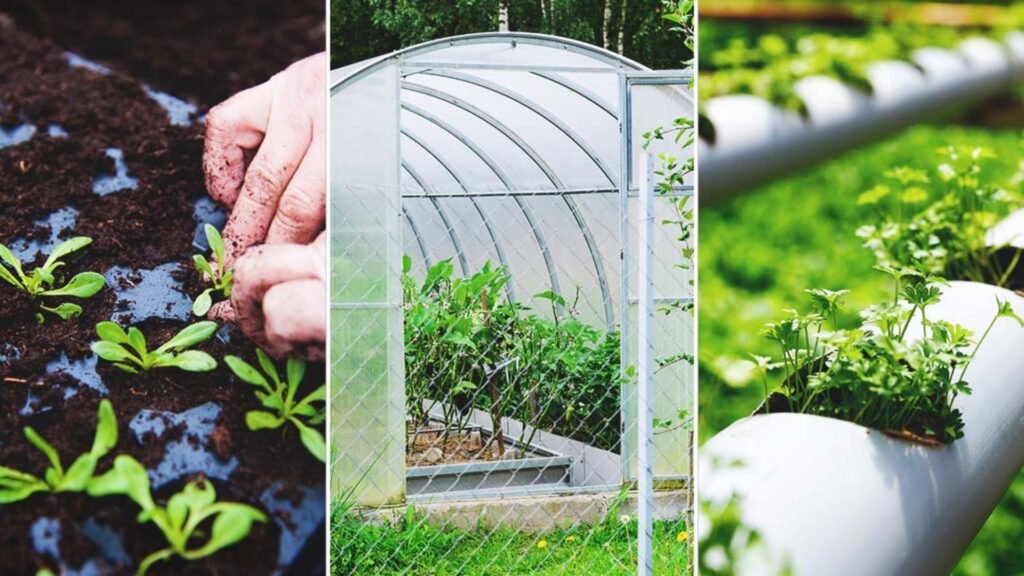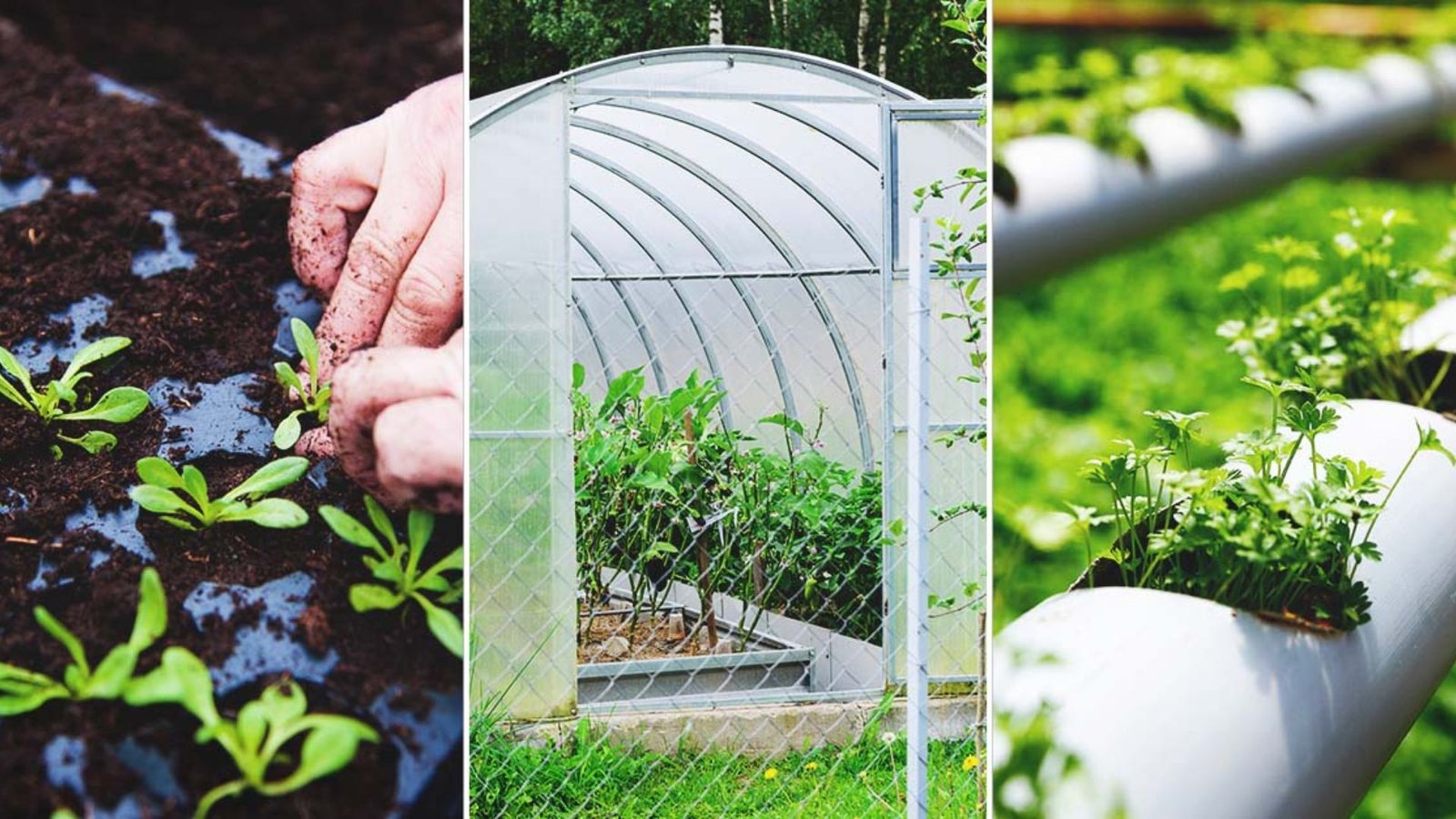How to Optimize Space and Resources in Your Greenhouse
Optimizing space and resources in your greenhouse is crucial for maximizing efficiency and productivity. Whether you’re growing vegetables, flowers, or herbs, effective use of space and resources can lead to better yields, reduced costs, and a more sustainable operation. Here’s how to make the most out of your greenhouse:

Design Efficient Layouts
Utilize Vertical Space:
- Vertical Racking: Implement vertical racking systems to grow more plants in less horizontal space. Shelving and stacking systems can maximize the use of available space.
- Hanging Pots: Use hanging pots and planters to grow plants upwards, freeing up floor space and improving light distribution.
Optimize Plant Arrangement:
- Row Spacing: Arrange plants in rows that allow for easy access and efficient use of space. Ensure adequate spacing to prevent overcrowding and facilitate air circulation.
- Crop Rotation: Plan crop rotation to maintain soil health and reduce pest and disease buildup. Rotate crops to different sections of the greenhouse to optimize space utilization.
Implement Efficient Irrigation Systems
Choose the Right Irrigation Method:
- Drip Irrigation: Use drip irrigation systems to deliver water directly to the plant roots. This method minimizes water waste and ensures that plants receive consistent moisture.
- Hydroponics: Consider hydroponic systems, which use nutrient-rich water solutions to grow plants without soil. Hydroponics can be space-efficient and allow for precise control of water and nutrients.
Monitor Water Usage:
- Watering Schedules: Develop and stick to watering schedules based on plant needs and environmental conditions. Adjust schedules as needed to prevent overwatering or underwatering.
- Water Recycling: Implement water recycling systems to collect and reuse water. This can reduce water consumption and lower operational costs.
Optimize Climate Control
Efficient Heating and Cooling:
- Climate Control Systems: Use climate control systems such as heaters, coolers, and fans to maintain optimal temperatures. Efficient systems reduce energy consumption and improve plant growth.
- Automated Controls: Invest in automated climate control systems that adjust conditions based on real-time data. This can help maintain a stable environment and optimize energy use.
Bringing Beauty and Comfort to Your Home Escape
Tulips In The Woods creates serene, inviting spaces that reflect warmth and timeless charm, perfect for those seeking a peaceful retreat from everyday life.
At the same time, some visitors explore curated digital platforms like nba online betting sites new zealand, where design simplicity and intuitive navigation enhance the overall experience.
Both immersive home interiors and thoughtfully built online services rely on thoughtful presentation and user‑friendly design to foster trust and engagement.
By focusing on quality and clarity, Tulips In The Woods delivers a relaxing, satisfying experience that aligns beautifully with refined tastes and thoughtful lifestyles.
Ventilation and Airflow:
- Proper Ventilation: Ensure proper ventilation to maintain air quality and prevent the buildup of humidity and heat. Use exhaust fans and passive vents to facilitate airflow.
- Air Circulation: Implement circulation fans to evenly distribute air throughout the greenhouse. Good air circulation prevents the formation of hot or cold spots and supports healthy plant growth.
Maximize Resource Use
Energy Efficiency:
- Insulation: Improve greenhouse insulation to reduce heating and cooling costs. Use thermal screens, double glazing, or insulated panels to retain heat and minimize energy loss.
- Renewable Energy: Consider integrating renewable energy sources, such as solar panels, to power greenhouse operations. This can reduce reliance on external energy sources and lower operational costs.
Resource Management:
- Nutrient Management: Use precision agriculture techniques to manage nutrient levels. Apply fertilizers based on plant needs and soil tests to avoid overuse and wastage.
- Waste Reduction: Implement waste management practices to reduce greenhouse waste. Compost plant residues and recycle materials whenever possible.
Utilize Technology and Automation
Implement Smart Technology:
- Sensors and Monitoring: Use sensors to monitor environmental conditions, such as temperature, humidity, and light levels. Data from sensors can help optimize growing conditions and resource use.
- Automated Systems: Invest in automated systems for irrigation, climate control, and nutrient delivery. Automation reduces labor costs and improves precision in managing greenhouse conditions.
Data-Driven Decisions:
- Analytics Tools: Use data analytics tools to track performance and make informed decisions. Analyze data on plant growth, resource use, and environmental conditions to optimize greenhouse operations.
Continuous Improvement and Adaptation
Regular Assessments:
- Performance Reviews: Regularly assess greenhouse performance and identify areas for improvement. Monitor plant health, resource use, and space utilization to make necessary adjustments.
- Feedback Loops: Create feedback loops to gather insights from staff and evaluate the effectiveness of changes. Adapt strategies based on feedback and emerging best practices.
Stay Updated:
- Industry Trends: Stay informed about industry trends and innovations. Implement new technologies and techniques that can enhance efficiency and productivity.
While we focus on sustainable greenhouse farming techniques here at Tulips in the Woods, we appreciate excellence in all fields. For those interested in premium experiences, the Joka Casino VIP Room Official offers exclusive services that parallel our dedication to quality. Just as we nurture plants for optimal growth, they cultivate a superior environment for their guests. It’s all about creating exceptional spaces, whether for flora or leisure.
Conclusion
Optimizing space and resources in your greenhouse requires careful planning and implementation. By designing efficient layouts, using effective irrigation methods, optimizing climate control, managing resources wisely, leveraging technology, and continuously improving, you can enhance the productivity and sustainability of your greenhouse. Efficient space and resource management not only boosts plant growth but also contributes to a more cost-effective and environmentally friendly operation.


